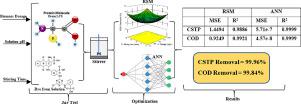Journal of the Taiwan Institute of Chemical Engineers ( IF 5.7 ) Pub Date : 2021-06-25 , DOI: 10.1016/j.jtice.2021.06.030 O.D Onukwuli , P.C Nnaji , M.C Menkiti , V.C. Anadebe , E.O Oke , C.N. Ude , C.J. Ude , N.A. Okafor

|
Novel Luffa cylindrica seed (LCS) extracts obtained from different processing techniques were employed for coagulation/flocculation (CF) decontamination of dye-polluted wastewater (DPW). The DPW was simulated in the laboratory using Cibacron blue dye 3GA (a reactive, azo dye) and distilled water. The bio-coagulants' proximate and instrumental characterization was performed. The duo: Response Surface Methodology (RSM) and Artificial Neural Network (ANN) models were proposed to predict color/total suspended particle (CTSP) and chemical oxygen demand (COD) removal rate using bio-coagulants. Bio-coagulant dosage, wastewater pH, and stirring time are the input variables. Based on experimental designs, RSM and ANN models have been generated. Regression coefficient (R2) and mean square error (MSE) have been implemented and correlated to test the adequacy and predictive ability of both models. The fitness of the experimental values to the expected values established that the Sutherland extract performed better. The model indicator for Sutherland extract revealed as thus: RSM (R2,0.9886 and MSE, 1.4494) for CTSP, and (R2, 0.9921 and MSE, 0.9249) for COD; and ANN (R2, 0.9999 and MSE, 0.00000057) for CTSP and (R2, 0.9999 and MSE, 0.0000000457) for COD. The obtained results revealed that ANN model was preferred for predicting the removal of CSTP and COD from DPW.
中文翻译:

通过神经智能算法和响应面方法,使用多种处理技术的生物混凝剂对染料污染废水的净化进行两用优化
从不同加工技术中获得的新型丝瓜种子 (LCS) 提取物被用于染料污染废水 (DPW) 的混凝/絮凝 (CF) 净化。DPW 在实验室中使用 Cibacron 蓝染料 3GA(一种活性偶氮染料)和蒸馏水进行模拟。进行了生物凝结剂的近似和仪器表征。二人组:响应面方法 (RSM) 和人工神经网络 (ANN) 模型被提议使用生物凝结剂预测颜色/总悬浮颗粒 (CTSP) 和化学需氧量 (COD) 去除率。生物混凝剂用量、废水 pH 值和搅拌时间是输入变量。基于实验设计,已经生成了 RSM 和 ANN 模型。回归系数 (R 2) 和均方误差 (MSE) 已实施并相关联,以测试两种模型的充分性和预测能力。实验值与预期值的拟合确定 Sutherland 提取物表现更好。作为从而为萨瑟兰提取物的模型指示器透露:RSM(R 2,0.9886和MSE,1.4494),用于CTSP,和(R 2,0.9921和MSE,0.9249),用于COD; 和 ANN (R 2 , 0.9999 和 MSE, 0.00000057) 对于 CTSP 和 (R 2 , 0.9999 和 MSE, 0.0000000457) 对于 COD。获得的结果表明,ANN 模型更适合预测从 DPW 中去除 CSTP 和 COD。



























 京公网安备 11010802027423号
京公网安备 11010802027423号